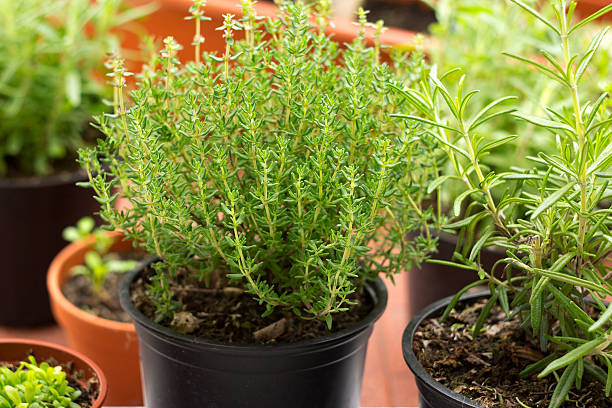
Thyme is widely used in culinary, medical and cosmetic practice. Due to its aroma, unusual taste and useful properties, the plant is rapidly gaining popularity among housewives.
For growing thyme at home, you need to properly carry out its landing, to provide the necessary illumination, optimal temperature and humidity.
Content
Is it possible to grow thyme in a pot?
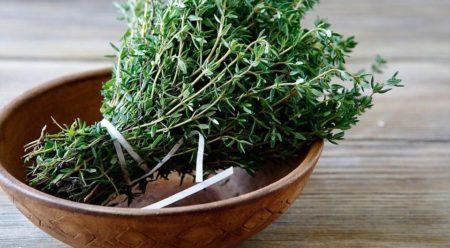
Spices do not need special growing conditions, so in the apartment he feels comfortable. To grow thyme at home, we take a pot of a suitable size, prepare a soil mixture and provide proper care.
Suitable varieties
The most unpretentious, suitable for growing at home are the following types of thyme:
- ordinary;
It is characterized by small leaves pubescent from below, with flowers of white or lilac color.
- citric;
It has a lemon aroma and yellow (in young plants) or light green (in adults) foliage.
- dwarf;
The bush of such thyme grows no higher than 5 cm. It grows densely and blooms with white, red and red flowers.
- creeping;
It is characterized by creeping stems and bright pink or raspberry flowers.
- rainbow;
A beautiful variety that is beneficial to grow on the windowsill. Why? - It is recommended to use it as a seasoning. Has flowers of violet and pink color.
- Bogorodsky.
It has thin creeping stems with pink and purple flowers. It is characterized by a bright aroma and bitter taste.
Choosing a Place for Indoor Thyme
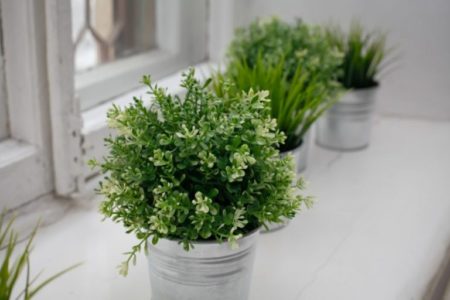
In order for the thyme to feel comfortable in apartment conditions, it is necessary to provide it with proper lighting, and put the pot in a place where the air temperature and humidity are suitable for its growth. Growing thyme on the windowsill is possible under the following conditions.
Lighting
Thyme is a light-loving plant, so for its cultivation we choose a window sill with good lighting. We put pots with a plant on the south window, it will be the most suitable. In winter, we provide spices with extra light, because the daylight becomes much shorter, and the thyme grown without proper lighting loses its rich aroma.
Temperature and humidity
In summer, you do not need to regulate the temperature and humidity of the air, as thyme sprouts under normal conditions. But in winter we provide temperature conditions in the range of 5-13 ° С. You can transfer thyme to a glazed balcony.
Regarding humidity, the plant does not require special conditions. But in order to increase its branching and transform the appearance of a houseplant, it is recommended to carry out periodic spraying. We carry them out only in a warm room, otherwise we will get the opposite effect.
Preparation for planting thyme at home
For proper planting, we adhere to the following steps and recommendations that will help to properly grow thyme from seeds or cuttings:
- Choose the capacity. To grow thyme in room conditions, it is recommended to give preference to clay pots or small boxes made of plastic. Thyme has a small root system, so a shallow pot is most suitable for planting it. Its maximum height should be 15 cm, otherwise the plant will not absorb enough water from the soil and it will block. Do not forget to scald the surface of the pot with boiling water. At its bottom, we must pour a layer of expanded clay or any other drainage, 2-3 cm high.
- Preparing the soil. We choose the earth light and loose. Of the prepared soil mixtures, one that is intended for growing cacti is well suited, pre-mix it with chernozem (2: 1). You can also mix peat, turf and sandy soils (1: 1: 1).
How to grow thyme on a windowsill
You can plant thyme at home in the following ways:
- seed;
- cuttings.
How to grow thyme from seeds at home
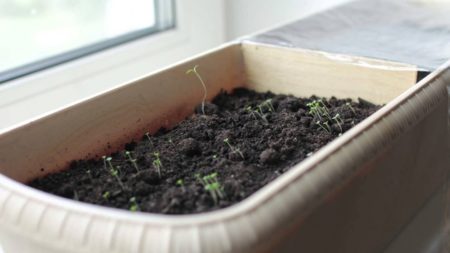
Growing thyme from seeds is very simple. To do this, pour a drainage layer into the pot. We mix the prepared soil with vermiculite so that moisture is better retained in it. Moisturize the soil and sow the seeds. Next, fill them with earth, the layer of which does not exceed 1 cm.
For seed cultivation, we place the pot in a shaded place so that direct sunlight does not burn the young shoots. Spray the soil regularly. As soon as the seedlings have risen, we remove a small number of them to provide space for the full growth of the plant.
How to grow thyme cuttings
To grow thyme at home in a pot with cuttings, cut off its shoots after flowering, and clean them from leaves. As a result, we get cuttings. In the prepared pot with drainage, we fill the soil and make holes in it up to 2 cm deep. We place cuttings in them and sprinkle them with earth a little. Until the first leaves appear, we conduct daily watering.
To grow thyme from shoots, you can also use purchased herbs. We select the branches that are best preserved and make a cut at their stems at an angle. We remove the lower leaves and put the stalk in water for 5-6 hours. Pour drainage, soil into the pot, make holes, deepen the cuttings in them, sprinkle with earth and spray. Next, cover the pot with a jar or wrap it in a bag. After 2-3 weeks, we remove the jar / bag, since by this time the root system is formed in the cuttings.
If there is a need to dilute thyme at home without using soil, then we pour water at room temperature into a darkened glass and throw activated carbon (1 tablet) or hydrogel (several granules) into it. Put the cup in the bag and tie it. The roots will “break through” in 20 days. Next, gently transplant the cuttings into a pot so that the hydrogel granules do not “fall off” when planting.
Thyme on the windowsill
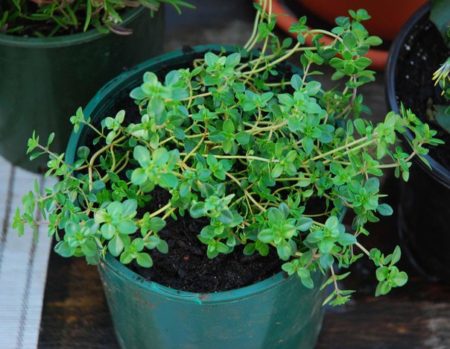
To properly care for thyme, you need to take into account the characteristics of this plant. Thyme can safely “boast” of its drought tolerance, so it does not need frequent watering. We carry it out as the soil dries, but so that it does not completely dry out. Since the spice feels good in loose soil - home care for thyme includes regular cultivation of its surface. Do not forget to provide proper lighting and adhere to the necessary temperature conditions.
To thyme in a pot grew denser and more magnificent - periodically cut its shoots. We carry out this procedure in the first months of spring and after flowering.
If, in spite of regular watering, the plant dries, we carry out fertilizing with mineral fertilizers.
Harvesting
Fresh thyme can be used all year round. To do this, carefully cut off its shoots with scissors.
To collect a more aromatic and saturated crop, it is recommended to cut the shoots in the middle of summer, at the end of the plant's life cycle. We lay them out on paper or hang bunches away from sunlight in a well-ventilated room. After drying, remove the thick stems, and chop the rest and store in a dark place in a hermetically sealed container for up to 2 years.
Reviews
Olga Nikolaevna
“Thyme does not like excessive watering at all. Due to the fact that the seedlings grew in a glass without drainage, some sprouts died because watering could not be adjusted. Therefore, you need to fill the drainage or moisten the earth only from the spray gun. "
Zina Olegovna
“I love thyme very much. Growing a house in a pot allows you to enjoy its aroma and taste year-round. It grows on the south windowsill, I did not have problems with it. I use it as a seasoning for meat and add it to tea. ”
Inna Sergeevna
“And I use thyme as a way of decorating window sills in an apartment. How to plant? “I choose the original pots and plant the seeds.”
Growing thyme at home is very simple. The main thing is to adhere to the basic rules for planting it in the ground, as well as to ensure proper watering and a sufficient amount of light, proper planting and care of the plant - an important part of its full development. As a result, the spice will delight with its magnificent growth, colorful flowering and rich aroma.

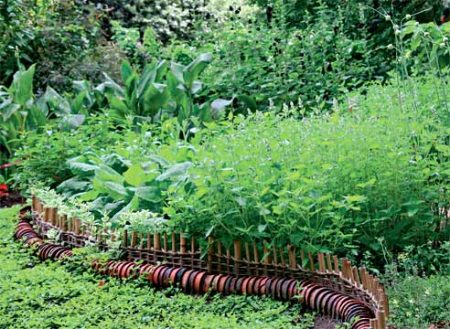

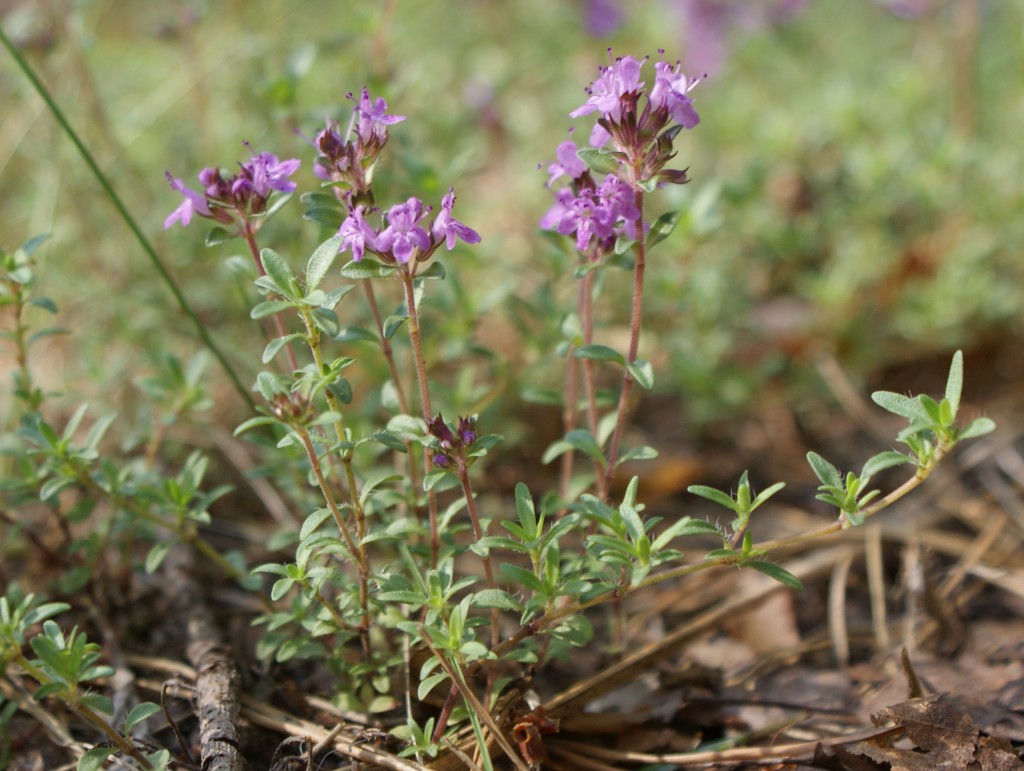 Creeping thyme: variety description, cultivation in open ground, planting and care
Creeping thyme: variety description, cultivation in open ground, planting and care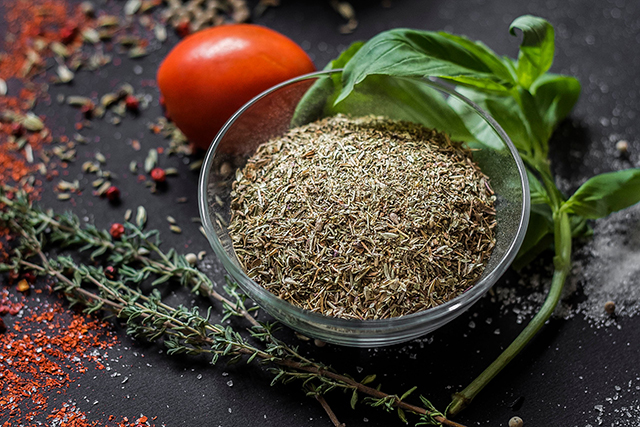 How to grow thyme from seeds in open ground with a photo
How to grow thyme from seeds in open ground with a photo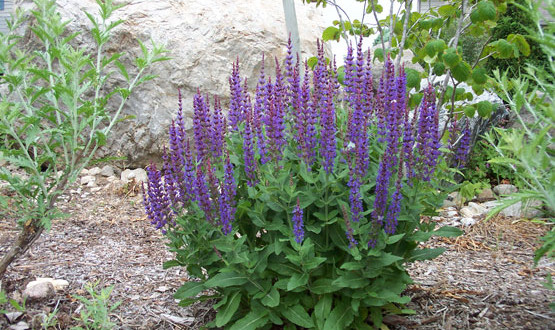 How to grow thyme in open ground near Moscow
How to grow thyme in open ground near Moscow